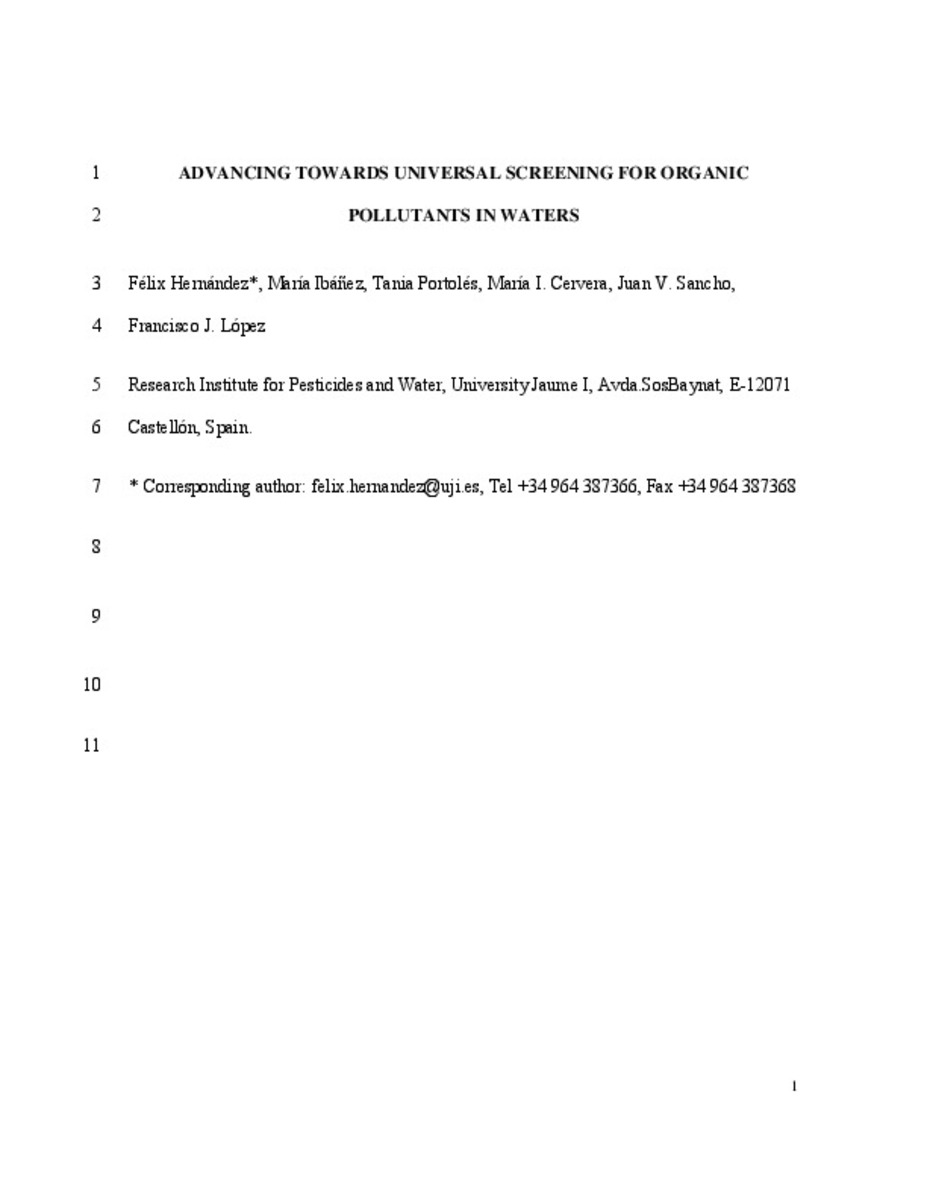Mostrar el registro sencillo del ítem
Advancing towards universal screening for organic pollutants in waters
| dc.contributor.author | Hernandez, Felix | |
| dc.contributor.author | Ibáñez, Maria | |
| dc.contributor.author | Portoles, Tania | |
| dc.contributor.author | Cervera Vidal, María Inés | |
| dc.contributor.author | Sancho, Juan V | |
| dc.contributor.author | Lopez, Francisco | |
| dc.date.accessioned | 2015-12-18T08:13:46Z | |
| dc.date.available | 2015-12-18T08:13:46Z | |
| dc.date.issued | 2015 | |
| dc.identifier.citation | HERNÁNDEZ, Félix, et al. Advancing towards universal screening for organic pollutants in waters. Journal of hazardous materials, 2015, vol. 282, p. 86-95. | ca_CA |
| dc.identifier.issn | 0304-3894 | |
| dc.identifier.uri | http://hdl.handle.net/10234/143986 | |
| dc.description.abstract | Environmental analytical chemists face the challenge of investigating thousands of potential organic pollutants that may be present in the aquatic environment. High resolution mass spectrometry (HRMS) hyphenated to chromatography offers the possibility of detecting a large number of contaminants without pre-selection of analytes due to its accurate-mass full-spectrum acquisition at good sensitivity. Interestingly, large screening can be made even without reference standards, as the valuable information provided by HRMS allows the tentative identification of the compound detected. In this work, hybrid quadrupole time-of-flight (QTOF) MS was combined with both liquid and gas chromatography (using a single instrument) for screening of around 2000 compounds in waters. This was feasible thanks to the use of atmospheric pressure chemical ionization source in GC. The screening was qualitatively validated for around 300 compounds at three levels (0.02, 0.1, 0.5 μg/L), and screening detection limits were established. Surface, ground water and effluent wastewater samples were analyzed, detecting and identifying a notable number of pesticides and transformation products, pharmaceuticals, personal care products, and illicit drugs, among others. This is one of the most universal approaches in terms of comprehensive measurement for broad screening of organic contaminants within a large range of polarity and volatility in waters. | ca_CA |
| dc.description.sponsorShip | The authors acknowledge the financial support from Plan Nacional de I+D+i, Ministerio de Economía y Competitividad (Project ref CTQ2012-36189), and from Generalitat Valenciana (Group of Excellence Prometeo 2009/054; Collaborative Research on Environment and Food Safety, ISIC/2012/016). The contribution of Fundación Dávalos-Fletcher to the development of this work is highly appreciated by the authors. | ca_CA |
| dc.format.extent | 10 p. | ca_CA |
| dc.format.mimetype | application/pdf | ca_CA |
| dc.language.iso | eng | ca_CA |
| dc.publisher | Elsevier | ca_CA |
| dc.relation.isPartOf | Journal of hazardous materials, 2015, vol. 282 | ca_CA |
| dc.rights | Copyright © 2015 Elsevier B.V. | ca_CA |
| dc.rights.uri | http://rightsstatements.org/vocab/InC/1.0/ | * |
| dc.subject | Liquid chromatography | ca_CA |
| dc.subject | Gas chromatography | ca_CA |
| dc.subject | Quadrupole time of flight mass spectrometry | ca_CA |
| dc.subject | Universal screening | ca_CA |
| dc.subject | Water samples | ca_CA |
| dc.subject | Organic micropollutants | ca_CA |
| dc.title | Advancing towards universal screening for organic pollutants in waters | ca_CA |
| dc.type | info:eu-repo/semantics/article | ca_CA |
| dc.identifier.doi | http://dx.doi.org/10.1016/j.jhazmat.2014.08.006 | |
| dc.rights.accessRights | info:eu-repo/semantics/openAccess | ca_CA |
| dc.relation.publisherVersion | http://www.sciencedirect.com/science/article/pii/S030438941400661X | ca_CA |
| dc.type.version | info:eu-repo/semantics/acceptedVersion |
Ficheros en el ítem
Este ítem aparece en la(s) siguiente(s) colección(ones)
-
IUPA_Articles [306]







